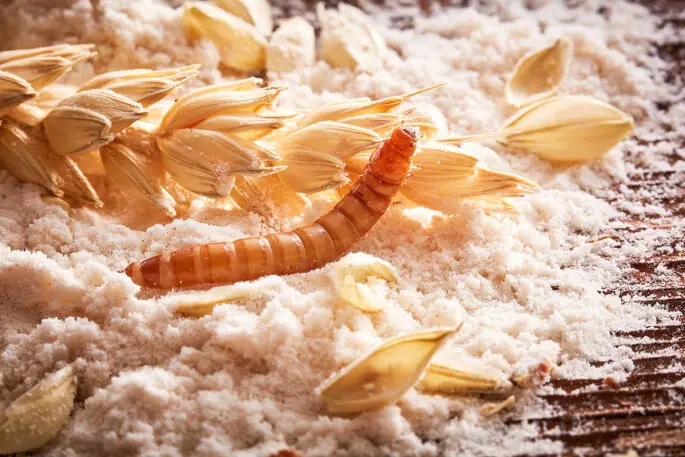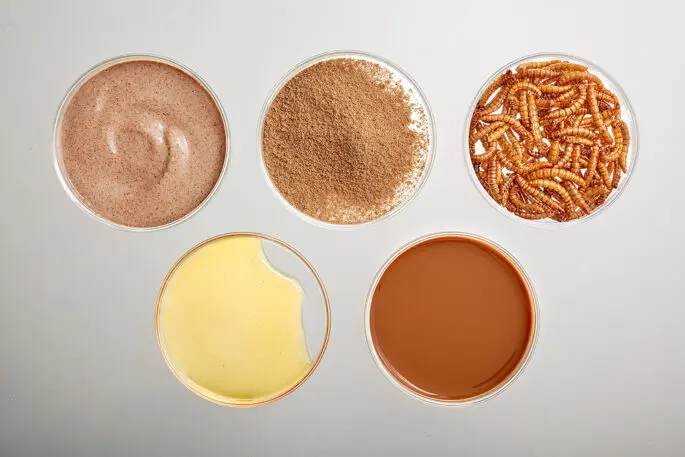Pet owners increasingly want their dogs and cats to eat the same food they do. There’s been a boom in premium, “human-grade” pet food that contains ingredients like organic turkey and lamb, wild-caught fish, root vegetables, and non-GMO superfoods, packed with vitamins and minerals.
Now, a French company is betting that pet owners will pay these high price points—but for bugs. The company, Ÿnsect, is counting on the rich nutritional profile of their mealworm pet food products. Citing growing interest from pet owners in feeding bugs to their critters, the company will sell its ground-up mealworm to high-end pet food retailers, which then sell their own insect-incorporated products to customers.

For the past 11 years, Ÿnsect has studied how to incorporate insects into diets for plants, pets, farmed fish, piglets—and humans. But it takes a lot of separate research on all fronts, so the company has now pivoted to prioritize pets, with its new launched brand, Sprÿng.
They want to tap into the massive pet food market, which is almost $100 million globally. In 2021, insect-based pet food represented 7% of the market, and it’s expected to grow almost 10% in the next decade. Data also suggests that people are increasingly accepting this option: 47% of owners would feed their pets insects, versus 36% in 2019. “It’s not a done deal,” says Alice Pabst Landon, head of marketing for Ÿnsect, “but we have so many customers who want it. The market is asking for it.”

The pet food industry has a heavy environmental impact (some refer to it as the “carbon pawprint”), which is responsible for 25% to 30% of emissions in food production, or 64 million metric tons of carbon a year—about the same as 13.6 million cars driving for a year. Insect production generates 10 times fewer carbon emissions, and uses 25% less water and 30 times less land.
As pet ownership itself has grown over the past three decades—and spiked during the pandemic—people have a stronger feeling of pets as part of the family. “We are saying ‘pet parents’ now,” Landon says. Especially in the U.S., trends show that owners are more willing to feed their pets premium quality meat and fish products, similar to what they’d eat themselves—and pay for it. “If you look at labels on pet food, you will see that it is crazy,” she says. “[They] are using chicken—real chicken—that could be eaten by humans.”
That’s promising, because the price tags for insect-based food are high, due to their specially formulated nutritional content. While most brands on the market use black soldier flies, including Purina and Yora, Ÿnsect’s blends are made from 100% mealworms, which are the larvae form of the yellow mealworm beetle. It’s high in protein, omega-3, fiber, and low in ash, the name given to the mineral content that’s necessary but needs to stay low so as not to upset pet stomachs.
Landon has tried it herself. She says it’s lightly nutty, with a neutral taste and smell. (“I don’t eat pet food usually,” she notes.) More importantly, it’s appealing to pets.
Ÿnsect has two production facilities in France, and one recently acquired in Nebraska, its first in the U.S. The Amiens facility, an hour north of Paris, is taking a page from the leafy greens book, with its first vertical farm—the world’s largest for insects—which will be able to produce 160,000 tons of mealworms per year. It keeps mealworms on racks stacking 118 feet high, with the farm kept at optimal conditions—and can use less energy because mealworms like it dark.
Over the past year, it has raised $175 million and worked with vets and nutritionists to formulate different forms of the ground-up mealworm, including a dry and a wet food for dogs and cats. They’re also developing whole larvae for wild birds and backyard chickens.
Using its B2B2C model, they then sell those to luxury and specialist pet food companies, which use the insects as a single protein, or mix with others. Some of the early partnerships are with French company Virbac, and American luxury company Bernie’s. The latter has a product of Luxe Tenderloin Medallions, mixing the bugs with beef liver and cod liver.
After they’ve conquered the pet market, the plan is to return to humans. Two billion people around the world already eat insects, and there’s growing interest among the climate-conscious. “We’re going to have a lot of work to do to make humans happy to eat it,” Landon admits. “But I promise, in a few years, we will get to it.”
Recognize your brand’s excellence by applying to this year’s Brands That Matter Awards before the early-rate deadline, May 3.
